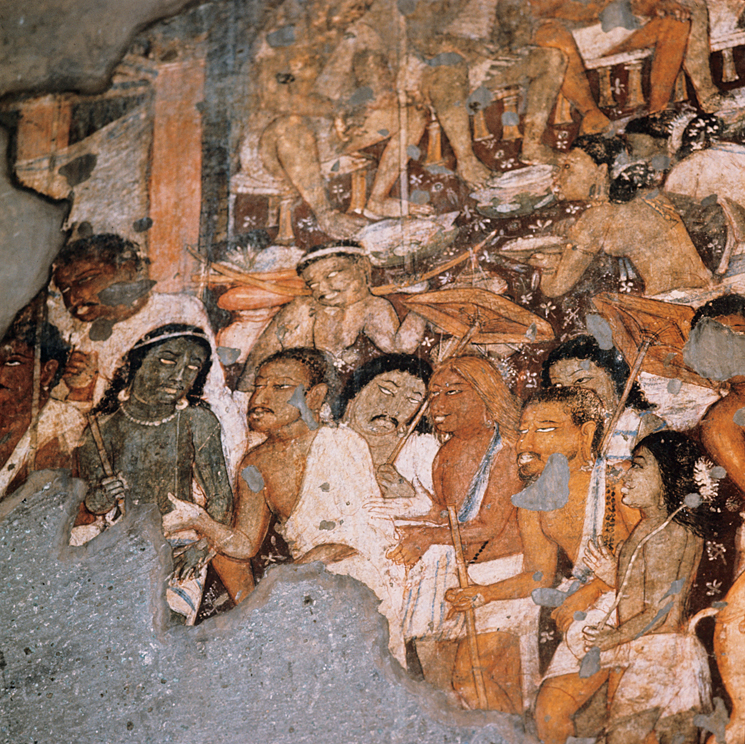A History of World Societies:
Printed Page 347
A History of World Societies Value
Edition: Printed Page 344
India’s Medieval Age and the First Encounter with Islam
After the decline of the Gupta Empire, India once again broke into separate kingdoms that were frequently at war with each other. Most of the dynasties of India’s medieval age (ca. 500–

Political division fostered the development of regional cultures. Literature came to be written in India’s regional languages, among them Marathi, Bengali, and Assamese. Commerce continued as before, and the coasts of India remained important in the sea trade of the Indian Ocean.
The first encounters with Islam occurred in this period. In 711, after pirates had plundered a richly laden Arab ship near the mouth of the Indus, the Umayyad governor of Iraq sent a force with six thousand horses and six thousand camels to seize the Sind area in western India (modern Pakistan). The western part of India remained part of the caliphate for centuries, but Islam did not spread much beyond this foothold. During the ninth and tenth centuries Turks from Central Asia moved into the region of today’s northeastern Iran and western Afghanistan, then known as Khurasan. Converts to Islam, they first served as military forces for the caliphate in Baghdad, but as its authority weakened (see “Chinggis’s Successors” and “The Mongols as Rulers”), they made themselves rulers of an effectively independent Khurasan and frequently sent raiding parties into north India. Beginning in 997 Mahmud of Ghazni (r. 997–

The new rulers encouraged the spread of Islam, but the Indian caste system (see “Life in Early India” in Chapter 3) made it difficult to convert higher-
They totally differ from us in religion, as we believe in nothing in which they believe, and vice versa. On the whole, there is very little disputing about theological topics among them; at the utmost they fight with words, but they will never stake their soul or body or property on religious controversy. . . . They call foreigners impure and forbid having any connection with them, be it by intermarriage or any kind of relationship, or by sitting, eating, and drinking with them, because thereby, they think, they would be polluted.6
After the initial period of raids and destruction of temples, the Muslim Turks came to an accommodation with the Hindus, who were classed as a protected people, like the Christians and Jews, and allowed to follow their religion. They had to pay a special tax but did not have to perform military service. Local chiefs and rajas were often allowed to remain in control of their domains as long as they paid tribute. Most Indians looked on the Muslim conquerors as a new ruling caste, capable of governing and taxing them but otherwise peripheral to their lives. The myriad castes largely governed themselves, isolating the newcomers.
Nevertheless, over the course of several centuries Islam gained a strong hold on north India, especially in the Indus Valley (modern Pakistan) and in Bengal at the mouth of the Ganges River (modern Bangladesh). Moreover, the sultanate seems to have had a positive effect on the economy. Much of the wealth confiscated from temples was put to more productive use, and India’s first truly large cities emerged. The Turks also were eager to employ skilled workers, giving new opportunities to low-
The Muslim rulers were much more hostile to Buddhism than to Hinduism, seeing Buddhism as a competitive proselytizing religion. In 1193 a Turkish raiding party destroyed the great Buddhist university at Nalanda in Bihar. Buddhist monks were killed or forced to flee to Buddhist centers in Southeast Asia, Nepal, and Tibet. Buddhism, which had thrived for so long in peaceful and friendly competition with Hinduism, subsequently went into decline in its native land.
Hinduism, however, remained as strong as ever. South India was largely unaffected by these invasions, and traditional Hindu culture flourished there under native kings ruling small kingdoms. (See “Individuals in Society: Bhaskara the Teacher.”) Devotional cults and mystical movements flourished. This was a great age of religious art and architecture in India. Extraordinary temples covered with elaborate bas-
